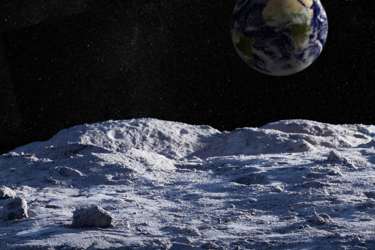NASA Acquires GPS Signals From The Lunar Surface

By John Oncea, Editor

For the first time in history, NASA successfully received and tracked GPS signals on the Moon, marking a major advancement in space navigation.
About a month ago, NASA and the Italian Space Agency acquired and tracked Global Navigation Satellite System (GNSS) signals. Cool.
Oh, did I mention the signals came from … the surface of the Moon?
This technological leap means that future exploration missions, including NASA’s Artemis missions, could benefit from these signals to determine their position, velocity, and time accurately and autonomously. This, according to NASA, represents a stepping stone to advanced navigation systems and services for the Moon and Mars.
“On Earth, we can use GNSS signals to navigate in everything from smartphones to airplanes,” said Kevin Coggins, deputy associate administrator for NASA’s SCaN (Space Communications and Navigation) Program. “Now, LuGRE shows us that we can successfully acquire and track GNSS signals at the Moon. This is a very exciting discovery for lunar navigation, and we hope to leverage this capability for future missions.”
The LuGRE payload on Firefly Aerospace’s Blue Ghost set three main records that day in March: transmitting trackable signals from 205,674 miles, then doing the same from Lunar Orbit (243,000 miles), and eventually from the Moon’s surface. The Lunar Orbit milestone is particularly notable as it means missions in cislunar space, the area of space between Earth and the Moon, could also rely on GNSS signals for navigation fixes.
The Road To The Milestone
Tracking spacecraft has long relied on a combination of measurements, including onboard sensors and signals from Earth-based tracking stations. The LuGRE payload was designed to show using GNSS signals for navigation could reduce reliance on human operators because these signals can be picked up and used autonomously by the spacecraft, even as far away as the Moon.
NASA continues, “The road to the historic milestone began on March 2 when the … Blue Ghost lunar lander touched down on the Moon and delivered LuGRE, one of 10 NASA payloads intended to advance lunar science. Soon after landing, LuGRE payload operators at NASA’s Goddard Space Flight Center in Greenbelt, MD, began conducting their first science operation on the lunar surface.”
The next day, at 2 a.m. EST, LuGRE acquired and tracked signals on the lunar surface and achieved a navigation fix approximately 225,000 miles away from Earth. This was accomplished by acquiring and tracking signals from two GNSS constellations, GPS, and Galileo, and using those signals for navigation on the lunar surface.
With the connection established, LuGRE – the first Italian Space Agency-developed hardware on the Moon – allowed the two agencies to collect data in a near-continuous mode.
100% Success
Firefly Aerospace’s two-week Blue Ghost Mission 1, the first fully successful commercial Moon landing, was wildly successful. In addition to proving the viability of acquiring and tracking GNSS signals, Blue Ghost transmitted more than 119 GB of data back to Earth, including 51 GB of science and technology data according to Space Watch Africa.
In addition to this, other payload milestones were completed on the Lunar surface. Blue Ghost carries a diverse suite of instruments to study the Moon. Mounted on its antenna gimbal, the Next Generation Lunar Retroreflector (NGLR) reflected laser pulses from Earth to accurately measure the Moon’s shape and distance.
On the top deck, the Lunar Environment heliospheric X‑ray Imager (LEXI) captured X‑ray images to analyze how solar wind interacts with Earth’s magnetic field. Additionally, Blue Ghost deployed the Lunar Magnetotelluric Sounder (LMS) via tethered electrodes and a mast to measure electric and magnetic fields deep beneath the surface, providing insights into the Moon’s internal composition.
Below the top deck, RadPC – a radiation-hardened computer – proved its resilience against space radiation. Above the lower deck, the Regolith Adherence Characterization (RAC) instrument examined how lunar dust sticks to various materials, helping improve future spacecraft and habitat designs.
Also mounted below the lower deck, the Stereo Cameras for Lunar Plume-Surface Studies (SCALPSS) documented the effects of engine plumes during descent and touchdown, while the Lunar Instrumentation for Subsurface Thermal Exploration with Rapidity (LISTER) drilled into the surface to measure heat flow from the Moon’s interior.
Finally, instruments on the surface access arm – Lunar PlanetVac and the Electrodynamic Dust Shield (EDS) – collected and sorted regolith samples and removed dust using electrodynamic forces, demonstrating low-cost, effective solutions for future lunar missions.
“After a flawless Moon landing, the Firefly team immediately moved into surface operations to ensure all 10 NASA payloads could capture as much science as possible during the lunar day,” said Jason Kim, CEO of Firefly Aerospace. “We’re incredibly proud of the demonstrations Blue Ghost enabled from tracking GPS signals on the Moon for the first time to robotically drilling and collecting science deeper into the lunar surface than ever before.”
Why This Is Important
The success of Blue Ghost Mission 1, particularly in acquiring and tracking GNSS signals, is a significant breakthrough for future space exploration. It demonstrates that Earth-based navigation systems can be adapted for deep space operations, offering a reliable, autonomous way to precisely position and maneuver spacecraft.
This technology could reduce reliance on traditional, resource-intensive ground tracking systems, lowering mission costs and complexities. Moreover, it paves the way for more flexible mission designs – not only around the Moon but potentially for journeys to Mars and beyond – by providing robust navigation support in environments previously considered challenging for GNSS. This advancement ultimately enhances mission safety, efficiency, and the overall potential for expanded human and robotic exploration in space.
